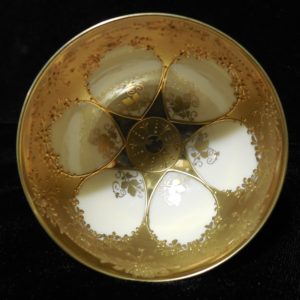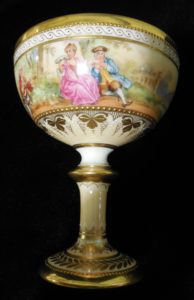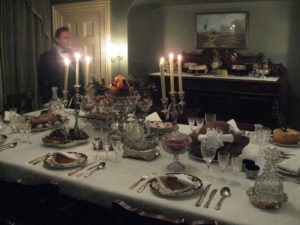
Detail of Sherbet Cup, c. 1914, Charles Ahrenfeldt and Ambrosius Lamm, Porcelain, Gift of Mr. and Mrs. Louis Bailey Audigier, 1934.1.238.69.2.

Sherbet Cup, c. 1914, Charles Ahrenfeldt and Ambrosius Lamm, Porcelain, Gift of Mr. and Mrs. Louis Bailey Audigier, 1934.1.238.69.2.
The Victorian dining table was loaded with flatware and china––a nod to the era’s taste for complex dining menus, obsession with formal etiquette, and the influence advertising had on consumers’ purchasing habits. The era’s trend towards service à la russe, in which each course was delivered to the table separately, required servants and clean table settings for each course.
Manufacturers took note, advertising and producing a dizzying amount of flatware, glassware, and china, like this sherbet cup and saucer, for all tastes and budgets.

A typical Victorian dinner table setting at the Sir George-Étienne Cartier National Historic Site of Canada in Old Montreal, Quebec.
This particular cup was made by Charles Ahrenfeldt, who moved his porcelain business to Limoges, France in the 1830s. It was then exported to Dresden, Germany where it was decorated by Ambrosius Lamm. Lamm’s studio became one of the leading workshops in Europe for decorative wares, typically featuring detailed figures and impasto work (raised gilt paste decorations).
Purchased by Eleanor Deane Audigier when she was living and traveling in Europe in the early 1910s, this sherbet cup is lavishly decorated, and is an example of the type of porcelain that would have graced the table of the upper class during that time period. It is decorated with fashionable scenes of courtesans.

Strawberry Sorbet
Why sherbet cups? Sherbet was a fashionable addition to the Victorian table. It is, as you can see below in a snippet from an 1899 cookbook, a “cooling drink” made from water and fruit juice (usually lemon)––only later was sherbet made with milk or egg white as well (in America––in Britain sherbet is a drink). Sherbet and sorbet came to be used interchangeably. It was meant to cleanse the palate between heavy multi-course Victorian meals.
From Mrs. Gillette’s Cook Book, 1899
Don’t believe me about the heavy Victorian meals? Check out the New York Public Library’s incredible “What’s on the menu?” database of menus, which are sortable by era. The menu below is pretty typical, and includes clams, consomme, a relish plate, fish, beef, lots of vegetable sides, and then a sorbet to cleanse the palette before some chicken, mayonnaise with lettuce, and lots of dessert. It makes my stomach hurt just thinking about it!
An 1899 meal for the Brooklyn Tabernacle Sunday School Association, Courtesy of New York Public Library, Call No. 1899-446.